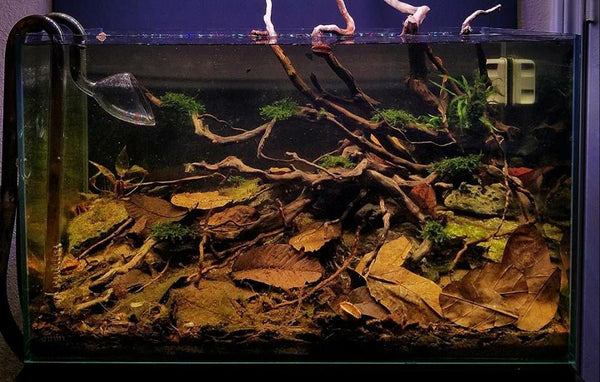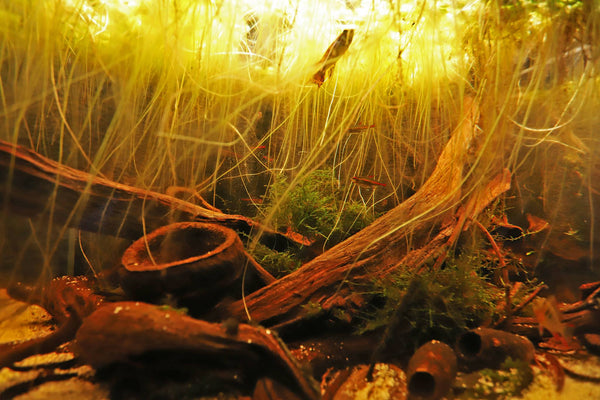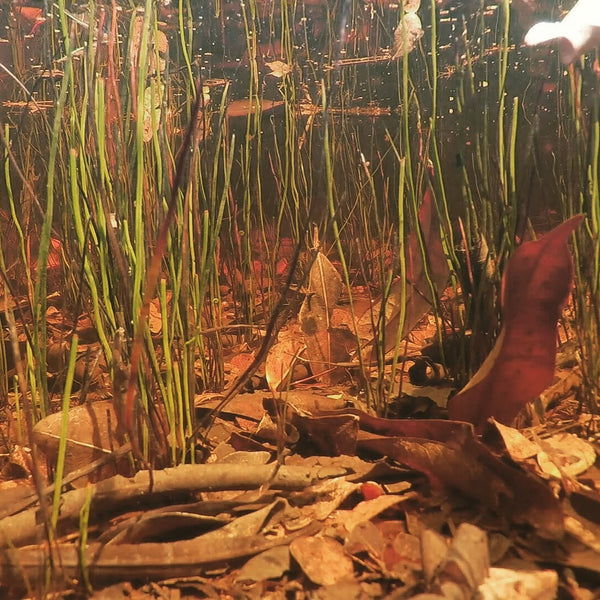- Continue Shopping
- Your Cart is Empty
Notes from the blackwater journey...
Have you felt a palpable change in our world?
I have. We're all sort of "travelers" along this path of discovery...
The idea of blackwater aquariums, with their tinted color and mysterious aesthetic is hardly "new" to the hobby world. No one really "invented" this. No one was the person who said, "We should all through leaves and seed pods in our tanks..." It just sort of...evolved.
Yep.
However, it seems to me that in the past few years, we're starting to see the blackwater, botanical-style aquarium move from "freak side show" to a broader, more mainstream acceptance within the hobby- pulling in people from all sorts of disciplines.
Something palpable. Something that calls us.
I've been at this botanical-influenced aquarium thing for about 18 now in "personal practice"; however, at a little over three years old, we're just getting underway with inspiring and motivating hobbyists to "play with pods" via Tannin Aquatics.

Although it seems a bit premature, and perhaps even self-serving to label the idea as a "movement" within the hobby, a number of fellow fish geeks have pointed out to me that they feel this is what's starting to happen; that this is what we have. I mean, you can sort of "feel" it. A lot of new energy, new ideas, and new exposure for this area previously labeled as a "novelty." A lot of cool people are doing some inspiring, amazing work with botanical-influenced aquariums.
We're looking beyond the everyday...
Okay, we will tentatively call it a "movement"- at least for the sake of discussion amongst ourselves, okay?
Already, we've noticed some interesting "trends" emerging among the growing number of hobbyists who are working with these types of tanks. These represent not only interesting developments in style and aesthetic, they demonstrate the level of open-mindedness and experimentation that's becoming so wonderfully and increasingly common in the hobby today.
First off, we're seeing hobbyists going beyond yesterday's "blackwater tanks look dirty" mindset, and embracing the aesthetic for what it is: A very natural-appearing "vibe" that replicates conditions found in certain natural environments around the world.
And with this acceptance of the "look" and ephemeral nature of botanicals in aquairums, a definite "mental shift" has occurred. This to me is most significant and important. Many hobbyists who have previously bought into the prevailing "brown is dirty" mindset are giving blackwater, botanical-influenced tanks a try, rather than flat-out dismissing the idea and (in our opinion) antiquated notions pushed around on the web that these aquariums are difficult to manage, unstable, and otherwise simply "fringe" novelties, rather than a legitimate specialty within the hobby.
This revelation backs up what many aquarists who dabbled with catappa leaves and bark and other stuff in botanical-influenced aquariums, particularly Betta breeders in Southeast Asia, have asserted for years. In particular, it's thought that these compounds, derived from botanicals, have anti-fungal and anti-parastic properties, and offer protection against oxidative DNA damage and from physiological stressors. With these health benefits now more clearly understood, there are more reasons than ever to appreciate the role that an environment which accumulates these humic substances can play in overall fish health.

Although the health benefits to fishes are fascinating and actually somewhat of a "game changer", like many hobbyists, my interests lie with the creation of aquarium that present a more natural-looking, functional aesthetic AS WELL as providing the physiological benefits as a sort of "collateral" bonus! And I think we're seeing a lot of hobbyists "getting their feet wet", trying a few leaves and/or botanicals almost tentatively in an aquascape, then "scaling up" to a full-blown, botanical-influenced "blackwater" aquarium.
And with it, not only are we seeing an explosion of new ideas and enthusiasm, we're seeing hobbyists enjoying a sort of "freedom of expression" in their aquascaping that, in some quarters has been lacking for so long, as we rigidly adhered to some "imposed rules" from a variety of sources. These "rules" were, in my opinion, stifling experimentation and individuality, resulting in a dearth of aquascapes, particularly in the international competitions, which looked almost "uniform" in appearance, with a trend towards creating an "underwater diorama", as one friend put it, instead of a miniature "slice of the bottom" as many have desired.
Look, I'm not implying that blackwater, botanical-influenced tanks are the "savior of the hobby", or even "the way forward." However, I am implying that seeing a diversity of hobbyists embrace what has been labeled by some as a radical departure from the "typical" style of aquarium (or previously little more than a "fringe sideshow") -and studying and utilizing the idea as a springboard for success with fishes- and as a form of creative expression- is creating a bit of "movement" in an area that was becoming increasingly one directional. It's nice to see new aquariums taking their cues from nature, instead of from the latest competition winner!
We see tanks set up specifically to create blackwater conditions for breeding. These are typically more "utilitarian" than purposefully aesthetically conceived, yet have a charm of their own. For example, Betta and Apisto keepers, who are creating botanical-influenced tanks for the sole purpose of providing more appropriate conditions for their fishes to spawn and grow in. And, they do just happen to look pretty cool...

We're seeing aquariums set up in a more "thematic" style- down with a high sense of design- a direct pedigree of the "Nature Style" aquarium, yet with a "blackwater/botanical twist." This has led to the creation of some amazing-looking aquariums that have turned a lot of heads in the planted tank/hardscape/"nature aquarium" community, in both "whitewater" and "blackwater" styles. Many hobbyists have taken us in exciting new directions, and countless others not even in the blackwater game yet will create works that will help further forge this style.

By adding a new look to a much-loved aesthetic, we're seeing a whole new group of very talented hobbyists creating gorgeous, aspirational aquariums simply by incorporating botanicals into the mix- with blackwater or otherwise.
What's really cool is that we are starting to see more and more planted blackwater/botanical-influenced tanks, an area that has previously been shunned by many, with the rationale that plants cannot work in such environments.
Look for a lot more cool developments on this front!

Perhaps even more exciting is that we're seeing more and more really cool "biotope-style" aquariums, with blackwater and botanicals as the pivotal components. Now, we've addressed before that there is a difference between the 100% true-to-every-stick-and-stone "biotope" aquarium, which seeks to replicate every detail of a specific locale, and a "biotope-type" aquarium, which simply presents an interpretation of a general environment.

Both have their merits, supporters, and philosophies, and are both fascinating. However, what's really exciting to me as that we've already seen aquariums that have a distinctly natural "look" to them, with less "intentional design" and more embrace of the natural processes which happen when materials like leaves and botanicals begin to soften and break down.
This "transitional" or "ephemeral"-style of escaping is the virtual embodiment of Amano's "wabi-sabi" aquatic aesthetic, and is winning over many new followers.
What I hope we never see in this "movement" are "rules" and rigid, close-minded thinking. Sure, nature may restrict us to what we can and cannot utilize or work with in the botanical environment, and there are some "best practices" in terms of husbandry of botanical systems, but we don't need to impose a dogmatic set of artificial principles to define and control the self-expression of others.
Nature calls all the shots here. She defines what works. She defines how stuff looks and functions. She'll correct you if you break one of her rules, and reward you when you embrace them. Listen to her. Follow her lead. Study her feedback.
And enjoy.

We simply need to enjoy what we're doing, share with others, and feel free to create as we desire. If we happen inspire and motivate others along the way, that's a beautiful thing. We can try all sorts of stuff; play with aesthetics.
We can hope mimic aspects of nature from the outset, with amazing aquascapes and such.
But it doesn't have to be strictly by design. Nature will do some of the heavy lifting for us, effortlessly creating via her processes aquatic microcosms as breathtaking as any "diorama" could ever hope to be.
If we allow her to do her work.

Okay, so I'm probably a bit more "attuned" to all of the goings on in our little niche than many others, simply because "my head is in it" all day.
However, I'm definitely not jaded, nor am I asserting that we've "invented" some incredible thing here.
What I am thinking is that the relentless exposure of some new and different-looking aquariums, thanks to many of you- is creating a new excitement, fostering a slightly different aquatic aesthetic- and promoting more interest in understanding some of the natural processes that influence both our fishes and the environments in which they live.

We are privileged to have a front-row seat to this evolving hobby speciality (okay, you can call it a movement!), and most important, are honored to be a part of the growing global community of fascinating, creative, courageous, and engaged hobbyists who are forging a dynamic new path in this amazing hobby that we all love so much.
Thanks for embarking on the journey. Forge ahead.
Stay fascinated. Stay bold. Stay curious. Stay relentless...
And Stay Wet.
Scott Fellman
Tannin Aquatics












Scott Fellman
Author